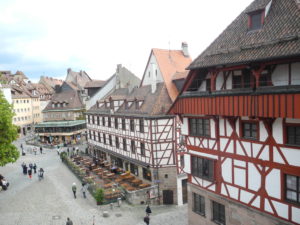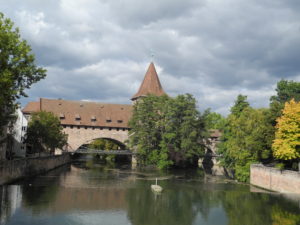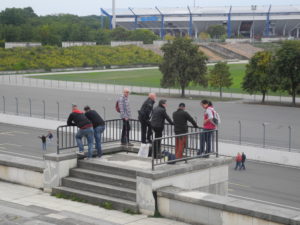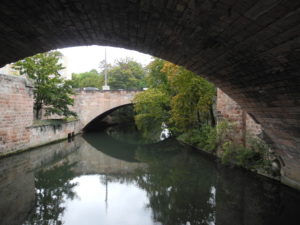
Nuremberg’s medieval city has been carefully reconstructed following Allied bombing in WWII. Photo by Clark Norton
I might never have visited Nuremberg, Germany, if it hadn’t been the starting point for a Danube River cruise last fall.
My wife, Catharine, and I arrived in Nuremberg several days early, intending to use it as a base for exploring the surrounding area, a region of Bavaria known for its charming medieval towns, rolling hills, and Autumn beer festivals.
But we ended up being so enamored of Nuremberg that we never left the city during our four-day stay there.
We were entranced by pathways leading intriguingly along ancient city walls, covered footbridges that crossed bucolic rivers and canals, flower-filled parks that attracted residents out for Sunday strolls, winding streets that unveiled tempting little restaurants and taverns, and half-timbered houses lining picturesque squares.
One square is anchored by the former home of the 16th-century master Albrecht Dȕrer, Germany’s greatest artist. You can tour his house and studio, considered palatial at the time, “guided” by the voice of his wife via English-language earphones, as well as view quality copies of some of his best-known works.
A Wealth of Surprises
The richness of the city’s attractions surprised me.
The only thing I really knew about Nuremberg — as I suspect is the case with many baby boomers, all born after World War II — was that it had been the site of some famous trials of Nazi war criminals shortly after Hitler’s defeat. I had long ago seen the movie Judgment at Nuremberg, starring Maximilian Schell as the chief prosecutor.

Covered bridges connect medieval Nuremberg to newer sections. of the city .Photo by Clark Norton.
But, while the film had made a lasting impression on me, it wasn’t the kind of impression that compelled me to visit. Nazi war criminals are hardly the stuff of irresistible travel brochures.
But as soon as Catharine and I disembarked from the train that had brought us from Frankfurt to the city’s bustling central station, my own pre-judgment of Nuremberg began to change.
Laid out before us was a meandering cobbled street that led one-and-a-half kilometers through a nearly perfect medieval town center up to our chosen lodging: a “youth” hostel that was built right into the side of the historic Imperial Castle that reigns over Nuremberg’s highest point.
The hostel, called Jugendherberge Nȕrnberg, turned out to be easier to afford than to pronounce. The location was unbeatable and the reasonable rates for a double room included a hearty German breakfast buffet. Best of all, for us, it attracted travelers of all ages to its sparkling clean, atmospheric quarters, which came with private baths if not armloads of amenities.
Exploring Nuremberg
When it came time to explore the city, we started at the adjoining Imperial Castle – also known as the Kaiserburg Fortress — wandering through the grounds and gardens, climbing a watchtower, admiring the panoramic views of the Old Town, and touring some of the rooms that included an 800-year-old Romanesque Chapel.
We learned that the castle was once one of the key royal palaces in the Holy Roman Empire, which spanned much of central Europe for a thousand years until the early 19th century. In the Middle Ages, dukes and counts traveled there to pay homage to newly crowned emperors, elevating Nuremberg to a position as one of the most important imperial cities.

Hitler stood here to address the massive Nazi rallies held in Nuremberg, “the most German of all cities.” Photo by Catharine Norton
But we were startled to discover that this medieval architectural gem had been nearly bombed to oblivion in World War II. Some 90 percent of it was destroyed, and it has since been carefully.reconstructed to its pre-war condition.
Even more surprising, we soon learned that the medieval city we had walked through en route to our hostel from the train station had also been mostly reduced to rubble by Allied bombers, and, like the castle, had been restored in the decades since to its former glory.
The sprawling Market Square lined with outdoor stalls selling everything from household goods to aromatic grilled wursts; the impressive churches and government buildings; the centuries-old restaurants and beer halls – most had been extensively damaged and later painstakingly returned to life.
The City’s Stark Past
This massive reconstruction project is both a monument to civic pride and a stark reminder of the evils of Nuremberg’s role in the rise of Nazism in the 1930’s, when Adolf Hitler lauded it as “the most German of all German cities.”
Hitler chose Nuremberg as the primary site of his massive Nazi Party Rallies, which filled local parade grounds with hundreds of thousands of mostly young Nazi zealots, whom Hitler extolled as the seeds of his envisioned thousand-year “Third Reich.”
The actual result, of course, was death, destruction, and eventual devastating defeat for Germany, culminated by the Nuremberg war crimes trials in Courtroom 600 (now site of a small museum) that led to the executions or imprisonment of numerous Nazi leaders.

Canals and walkways add peaceful, livable touches to a once-devastated city. Photo by Clark Norton
Following the war, Nuremberg residents tried to bury the reminders of Nazi horrors. The area around the old Nazi Party Rally Grounds became a center for sporting events, and the gargantuan Neo-Classical structures that Hitler’s chief architect, Albert Speer, had begun to build nearby became the eerie backdrop for lakeside hiking trails.
That changed with the construction of the compelling Documentation Center, an interactive museum that serves as a memorial to the Nuremberg Trials and the Nazis’ millions of victims.
Completed in 2001, the center occupies one corner of Speer’s crumbling paean to power, the Congress Hall, which surpasses the Roman Colosseum in size. Through a searing succession of videos, photos, and written words, the Documentation Center presents an unvarnished portrait of the atrocities perpetrated by the Nazi regime.
Less known, but still fascinating, is a tour of the World War II Art Bunkers that honeycomb the nether regions beneath Nuremberg’s Old Town.
Within these heavily reinforced, climate-controlled bunkers, the Nazis hid priceless art and other cultural treasures from the city’s churches, museums, and private collections, preserving the city’s cultural heritage for future generations. It was perhaps the only thing they managed to do right.
While Nuremberg’s role in the rise of Nazism is indeed disturbing, the modern-day city has now tackled its past head-on and become a bastion of peace built on the ashes of the old.
The Market Square, center of the colorful Old Town, is alive with food stalls and crowded sidewalk cafes; art and other museums abound; bicyclists and joggers fill the parks; and festivals and Christmas markets bring color to its seasons.
While Nuremberg must never forget its sometimes ignoble past, it has now earned the right to be judged by its alluring present and promising future.












Leave a Reply